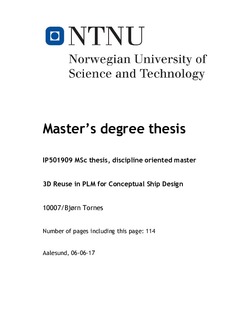| dc.description.abstract | Today 3D CAD tools have become more and more used in design processes, allowing amongst other better visualization of product, computer analysis of design, etc. Even so, in ship design, 3d-design is still combined with 2D drawings in the conceptual stage. At this point, developing the design in full 3D is not justifiable, since shipbuilding companies almost consistently use a no-cure no-pay principle at this stage. Using 3D vessel models and -software is just too complex and time-consuming. This, in its turn, causes situations where a lot of rework has to be done, because these drawings must be turned into 3D models in the subsequent stages. A method is needed to support the process and reduce the time it takes. PLM is a holistic business approach which promotes amongst others reuse of information. And the question arises; can PLM reuse simplify the 3D design process for use in conceptual ship design?
The main goal of this thesis is to create a framework where a virtual prototype can be built from existing components. The way the author wants to achieve this is by creating a library using PLM tools, where the components can be easily stored and reused in other projects. To do this a PLM reuse framework was adapted to maritime requirements. Additionally, the interfaces between vessel model and library were identified and a method to handle them found. Then these methods were applied to a case, with two different vessels, one of them where all components were designed to requirements and one where components from the previous vessel was reused.
From the cases, discussions were made about the challenges discovered and ways to improve the models. The discussions lead to a conclusion that while there are still elements to handle, PLM shows promise in providing a tool to reuse vessel components in the conceptual design stage. This thesis could only look into a few of the aspects in 3D reuse in ship design in one step of the lifecycle. PLM is about integrating data from all the stages and processes together, and the 3D components should be combined with data from these processes connecting the models with e.g. specifications, manuals, BOMs etc. When that is done the full benefits of PLM will be revealed. | nb_NO |

